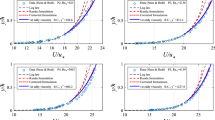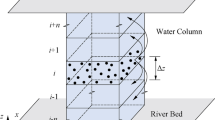Abstract
The distribution of suspended sediment particles in a steady, uniform and stratified turbulent flow through open-channels is investigated in this study using fractional advection–diffusion equation (FADE). Unlike previous studies on FADE, the FADE is employed with the effects of stratification due to the presence of the sediment particles. Analogous to the approach of stratified flow, the effect of stratification is connected with the damping of the sediment diffusivity. A general model of sediment diffusion coefficient in stratified flow is proposed which changes along vertical direction as well as with the order of the fractional derivative. Finally the model of sediment distribution is derived incorporating the effects of non-local transport of particles, stratification, hindered settling velocity and damping of mixing length. The model is solved numerically using the fractional Adams–Bashforth–Moulton method and solutions are validated with the experimental data. The validation results are satisfactory. The variation of the depth average sediment diffusion coefficient and the proposed model of sediment diffusion coefficient with the fractional order \(\alpha\) are investigated. The results show that with the decrease of fractional order \(\alpha\), the value of depth average sediment diffusion coefficient increases and the depth variable sediment diffusion coefficient shows a overall increases throughout the flow depth. The rationality of the dependence of \(\alpha\) on both types of sediment diffusion coefficients have been justified physically. It is also found that the effect of stratification results a decrease both for the suspension distribution and the sediment diffusion coefficient which is consistent with the results using traditional ADE.






Similar content being viewed by others
References
Baldock TE, Tomkins MR, Nielsen P, Hughes MG (2004) Settling velocity of sediments at high concentrations. Coast Eng 51(1):91–100
Bialik RJ, Nikora VI, Karpiński M, Rowiński PM (2015) Diffusion of bedload particles in open-channel flows: distribution of travel times and second-order statistics of particle trajectories. Environ Fluid Mech 15(6):1281–1292
Bradley D, Tucker G, Benson D (2010) Fractional dispersion in a sand bed river. J Geophys Res 115(F00A09):1–20
Businger JA, Wyngaard JC, Izumi Y, Bradley EF (1971) Flux-profile relationships in the atmospheric surface layer. J Atmos Sci 28:181–189
Cao Z (1997) Turbulent bursting-based sediment entrainment function. J Hydraul Eng 123(3):233–236
Cellino M, Lemmin U (2004) Influence of coherent flow structures on the dynamics of suspended sediment transport in open-channel flow. J Hydraul Eng 130(11):1077–1088
Chaves AS (1998) A fractiona diffusion equation to describe lévy flights. Phys Lett A 239:13–16
Chen D, Sun HG, Zhang Y (2013) Fractional dispersion equation for sediment suspension. J Hydrol 491:13–22
Cheng NS (1997) Effect of concentration on settling velocity of sediment particles. J Hydraul Eng 123(8):728–731
Coleman NL (1981) Velocity profiles with suspended sediment. J Hydraul Res 19(3):211–229
Coleman NL (1986) Effects of suspended sediment on the open-channel velocity distribution. Water Resources Res 22(10):1377–1384
Coles DE (1956) The law of the wake in the turbulent boundary layer. J Fluid Mech 1:191–226
Deng ZQ, Lima JD, Lima MD, Singh VP (2006) A fractional dispersion model for overland solute transport. Water Resources Res 42(W03416):1–14
Einstein HA, Chien NS (1955) Effects of heavy sediment concentration near the bed on velocity and sediment distribution. US Army Corps Engineers, Missouri River Division, report no 8
Foufoula-Georgiou E, Ganti V, Dietrich W (2010) A nonlocal theory of sediment transport on hillslopes. J Geophys Res 115(F00A16):1–12
Ghoshal K (2004) On velocity and suspension concentration in a sediment-laden flow: experimental and theoretical studies. Ph.D. thesis, Indian Statistical Institute, Kolkata
Glenn SM, Grant WD (1987) A suspended sediment stratification correction for combined wave and current flows. J Geophys Res 92:8244–8264
Grass AJ (1971) Structural factors of turbulent flow over smooth and rough boundaries. J Fluid Mech 50(2):233–255
Guo B, Pu X, Huang F (2015) Fractional partial differential equations and their numerical solutions. World Scientific, Singapore
Guo J (1998) Turbulent velocity profile in clear water and sediment-laden flows. Ph.D. thesis, Colorado State University, Fort Collins, CO
Herrmann MJ, Madsen OS (2007) Effect of stratification due to suspended sand on velocity and concentration distribution in unidirectional flows. J Geophys Res 112(C02006):1–13
Jackson RG (1976) Sedimentological and fluid-dynamic implications of the turbulent bursting phenomenon in geophysical flows. J Fluid Mech 77(3):531–560
Kovacs AE (1988) Prandtl’s mixing length concept modified for equilibrium sediment-laden flows. J Hydraul Eng 124(8):803–812
Kumbhakar M, Kundu S, Ghoshal K (2017) Hindered settling velocity in particle-fluid mixture: a theoretical study using the entropy concept. J Hydraul Eng 143(11):06017019
Kundu S (2018) Suspension concentration distribution in turbulent flows: an analytical study using fractional advection–diffusion equation. Phys A Stat Mech Appl 506:135–155
Kundu S (2018) Two parameter Mittag–Leffler solution of space fractional advection–diffusion equation for sediment suspension in turbulent flow. J Environ Eng ASCE 144(8):06018005
Kundu S, Ghoshal K (2014) Effects of secondary current and stratification on suspension concentration in an open channel flow. Environ Fluid Mech 14:1357–1380
Lelouvetel J, Bigillon F, Doppler D, Vinkovic I, Champagne JY (2009) Experimental investigation of ejections and sweeps involved in particle suspension. Water Resources Res 45(W02416):1–15
Lewis W, Gilliland E, Bauer W (1949) Characteristics of fluidized particles. Ind Eng Chem 41:1104–1127
Li C, Zhaoa Z, Chen Y (2011) Numerical approximation of nonlinear fractional differential equations with subdiffusion and superdiffusion. Comput Math Appl 62(3):855–875
Mao Y (2003) The effects of turbulent bursting on the sediment movement in suspension. Int J Sediment Res 18(2):148–157
Mazumder BS, Ghoshal K (2006) Velocity and concentration profiles in uniform sediment-laden flow. Appl Math Model 30:164–176
Monin AS, Yaglom AM (1971) Statistical fluid mechanisms. MIT Press, Cambridge
Muste M, Yu K, Fujita I, Ettema R (2009) Two-phase flow insights into open-channel flows with suspended particles of different densities. Environ Fluid Mech 9:161–186
Nielsen P, Teakle IAL (2004) Turbulent diffusion of momentum and suspended particles: a finite-mixing-length theory. Phys Fluids 16:2342–2348
Offen GR, Kline SJ (1974) Combined dye-streak and hydrogen-bubble visual observation of a turbulent boundary layer. J Fluid Mech 62(2):223–239
Pal D, Ghoshal K (2013) Hindered settling with an apparent particle diameter concept. Adv Water Resources 60:178–187
Paradisi P, Cesari R, Mainardi F, Tampieri F (2001) The fractional Fick’s law for non-local transport process. Physica A 293:130–142
Pittaluga MB (2011) Stratification effects on flow and bed topography in straight and curved erodible streams. J Geophys Res 116(F03026):1–20
Podlubny I (1999) Fractional differential equations. Academic Press, California
Prandtl L (1926) über die ausgebildete turbulenz. In: 2e internationaler kongress der technischen mechanik, Verhandlung. Füessli, Zürich
Prandtl L (1932) Recent results of turbulence research. Technical memorandum 720, National Advisory Committee for Aeronautics
Richardson JF, Zaki WN (1954) Sedimantation and fluidization part I. Trans Inst Chem Eng 32:35–53
Schumer R, Benson D, Meerschaert M, Wheatcraft S (2001) Eulerian derivation of the fractional advection dispersion equation. J Contam Hydrol 48(1):69–88
Schumer R, Benson DA, Meerschaert MM, Baeumer B (2003) Multiscaling fractional advection-dispersion equations and their solutions. Water Resources Res 39(1):10–22
Schumer R, Meerschaert MM, Baeumer B (2009) Fractional advection-dispersion equations for modeling transport at the earth surface. J Geophys Res 114(F00A07):1–15
Singh MK, Chatterjee A, Singh VP (2017) Solution of one-dimensional time fractional advection dispersion equation by homotopy analysis method. J Eng Mech 143(9):1–15
Smith JD, McLean S (1977) patially averaged flow over a wavy surface. J Geophys Res 82(12):1735–1746
Styles R, Glenn SM (2000) Modeling tratified wave and current bottom boundary layers on the continental shelf. J Geophys Res 105(C10):24119–24140
Vanoni VA (1946) Transportation of suspended sediment by running water. Trans ASCE 111:67–133
Wang X, Qian N (1989) Turbulence characteristics of sediment-laden flows. J Hydraul Eng 115(6):781–799
Weeks ER, Urbach JS, Swinney HL (1996) Anomalous diffusion in asymmetric random walks with a quasi-geostrophic flow example. Physica D 97(1):291–310
Zhang R, Xie J, Wan M, Huang J (1989) Dynamics of fluvial sediment transport. China Water Power Press, Beijing
Zheng YY, Li CP, Zhoa ZG (2010) A note on the finite element method for the space fractional advection dispersion equation. Comput Math Appl 59(5):1718–1726
Acknowledgements
The work is partially supported by the DST (SERB) sponsored Project with file No. ECR/2017/000184.
Author information
Authors and Affiliations
Corresponding author
Additional information
Publisher's Note
Springer Nature remains neutral with regard to jurisdictional claims in published maps and institutional affiliations.
Appendix: Some preliminaries on fractional derivatives
Appendix: Some preliminaries on fractional derivatives
It is well-known that there are a number of different kinds of definitions of fractional derivatives exists with their applications in various fields [19, 40]. Each definition has its own advantages and are suitable for applications to different type of problems. Among these the Caputo-type derivative is mostly employed in physical problems as it describes the physical behavior well [8, 40]. The Caputo fractional derivative of a function f(y) is defined as
where \(n-1<\alpha \le n\) and \(a\in [-\infty , y)\). When \(\alpha =n\in N\), Caputo fractional derivative represents the ordinary integer order derivative of order n i.e. \(\,_a^CD_{y}^{n}f(y)=f^{(n)}(y)\). The kernel of this fractional model is \((y-\tau )^{n-\alpha -1}\) which gives a power law function. The Eq. 27 can be considered as a convolution of two functions in the interval [a, y] and can be written as
This indicates that fractional derivative value depends on the derivative of the function over the whole interval [a, y]. Alternately, the Caputo fractional derivative can also be defined using the Riemann–Liouville fractional integral as
where \(D_y^m=\frac{d^m}{dy^m}\) and \(m-1<\alpha \le m\), \(y>0\) and \(m\in N\). Here \(\,_a^{RL}J_{y}^{\alpha }\) denotes the Riemenn–Liouville fractional integral of order \(\alpha >0\) which is defined as [40]
Rights and permissions
About this article
Cite this article
Kundu, S. Modeling stratified suspension concentration distribution in turbulent flow using fractional advection–diffusion equation. Environ Fluid Mech 19, 1557–1574 (2019). https://doi.org/10.1007/s10652-019-09679-9
Received:
Accepted:
Published:
Issue Date:
DOI: https://doi.org/10.1007/s10652-019-09679-9




